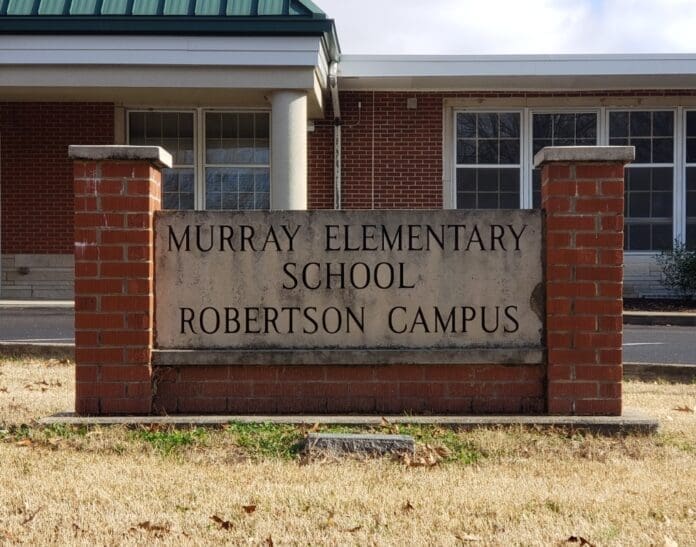
MURRAY – The Murray Board of Education approved the long-range local facilities plan for the Murray Independent School District (MISD) during its regular meeting Thursday. Over the next four years, the district hopes to invest around $65 million in its infrastructure, including $13 million in improvements to athletics facilities and $28 million to build a new elementary school.
A public hearing regarding the draft facilities plan preceded the board meeting. The hearing officer, Assistant Superintendent of Instruction and Human Resources Whitney York, reported that no written statements were received from the public prior to the hearing, and no one signed up to speak at the hearing. In the meeting that followed, the board unanimously approved the plan.
Prior to the board’s consideration of the plan, R.W. Baird & Co. Public Finance Director Mark Rawlings presented an overview of the district’s financial status, including an explanation of how bondable revenues are calculated and what that ultimately means for the district in terms of its bonding capacity. (See “Building fund revenue streams explained” below.)
“I want to tell you the headline that I’m bringing is, really, pretty good news, I think, for you guys tonight, especially as it pertains the ability to do the projects that were discussed on your facility plan,” he said.
Rawlings also outlined different borrowing scenarios showing the district’s bonding capacity ranging from $20 million to $45 million. Noting that Rawlings’ projections are based on attendance data from 2021, Superintendent Coy Samons said he thought the numbers presented were conservative. Rawlings agreed.
Looking at the details of the plan, the site for the new elementary school has yet to be determined. The 725-student-capacity building will house kindergarten through fourth grades; however, Board Chair Richard Crouch noted that he would like to see architects present a design that would easily accommodate building additions so that, in the future, fifth grade could be relocated from the middle school to the elementary school.
After the new school is built, the current elementary school building will be repurposed to house Murray Preschool Head Start, the central office and the maintenance shop, with the necessary renovations to make that a reality bearing price tags of $1.5 million, $4.8 million and $1.5 million, respectively.
The auditorium and gym locker rooms at Murray Middle School (MMS) will be completely remodeled for a price of $1.7 million and $756,000, respectively. Three new construction projects are planned for Murray High School (MHS) – a 325-seat auditorium ($1.9 million), a science room ($481,000) and an ag shop ($1.5 million). In addition, the bus garage, which is adjacent to the high school, in the old vocational school building, will undergo major renovations at a cost of $2.2 million.
The plan includes a district-wide initiative to outfit every classroom with fixed active boards and projectors with wireless capabilities to allow hand-held student assessments and remote operations. The white boards cost $6,500 each, and 50 will be needed to achieve the goal, which translates to a $325,000 investment.
The plan also covers seven discretionary projects focused on athletics totaling $13 million, including $1.5 million to relocate the baseball field to the MHS campus, add a bridge to the track and install a perimeter fence. Ty Holland Field is getting a $1.5 million makeover – a new press box and new seating to accommodate 1,500 on the home side and 750 on the visitor side.
The old Industrial Arts building on the MMS campus will be renovated to create new football and baseball locker rooms and a weight room; $3.8 million is allotted for that project. The district also plans to invest $4.8 million in renovations to the former vocational school building and create the Murray Athletic Complex, which will house a high school football locker room and practice spaces for archery, baseball and softball. In addition, the Hina Fieldhouse will be renovated ($720,000) and new lighting will be installed at the track ($250,000) and tennis courts ($400,000).
The board also approved a guaranteed energy savings contract (GESC) with Ascendant Facility Partners for $4.8 million. Ascendant Managing Principal Russ Litsinger advised the board that the upgrades and renovations included in the proposal would save the district $139,500 in the first year and nearly $3.7 million over the next 20 years.
Per the approved contract, nearly all buildings will have thermal envelope improvements to address issues with air leakage, which is a major source of heat loss and heat gain from the exterior to the interior; new plumbing fixtures will be installed to promote water conservation; interior and exterior lighting will be replaced with LED lights and occupancy controls will be installed to reduce electricity consumption; and HVAC systems will be rejuvenated, which is a process that involves cleaning, coating and straightening outdoor HVAC coils.
The remaining projects concern the middle and high schools. Solar panels will be installed on both schools and the outdated direct digital control systems (DDC) will be upgraded. The previously-described track light replacement project at MHS is included in the GESC, but the remaining projects focus on the middle school.
Inside the school, the kitchen hoods and the building’s two low-efficiency boiler units, which Litsinger characterized as being “beyond their effective life cycle,” will be upgraded. As for the exterior, the original building is getting a “period-appropriate” facelift. All of the windows and supporting infrastructure on the building’s south and east profiles will be replaced along with two sections of roof.
“This effort is really trying to pay homage to the building, put something back that is not only high performance but also speaks to the aesthetic of that building,” Litsinger said. “It’s a great building and a cultural treasure here in town, and we want to do right by that.”
Citing his grandson’s connection to a solar panel manufacturer, Crouch did not comment on the GESC and refrained from voting on the acceptance of Ascendant’s bid as well as the approval to forward the contract to the Kentucky Department of Education for approval. The remaining board members – Robyn Pizzo, Adam Sieber, Shawn Smee and Gina Winchester – all voted in favor of both actions.
Crouch did participate in the unanimous decisions to authorize the MISD Finance Corporation to pursue the issuance of bonds to cover aforementioned capital expenditures and to employ R.W. Baird & Co. to act as the district’s advisor and agent throughout the process.
In other business, the board approved a new CEO (continuing education option) rank change program for teachers. The proposed 2024-2025 calendar had its second reading, which included one change after the first reading, and was approved. Assistant Superintendent and Director of Pupil Personnel Lou Carter explained that, based on five-year weather trends, the number of required makeup days was amended from five to three.
Prior to adjourning, the board went into four executive sessions – one regarding the acquisition or sale of property, one regarding proposed or pending litigation and two regarding personnel matters – and reconvened in open session to approve the superintendent’s evaluation.
The next board meeting will be at 6 p.m. on Thursday, Jan. 11, at the Carter Administration Building.
Building fund revenue streams explained

As R.W. Baird & Co. Public Finance Director Mark Rawlings explained to the Murray Board of Education Thursday, the revenue streams for a school district’s building fund (also called restricted funds) are functions of the district’s size, wealth and need.
The first revenue stream is average daily attendance funding, which provides $100 per student, and 80% of those funds can be used to calculate bonding capacity.
The second is tax revenue. Districts are required to deposit at least 5 cents per $100 assessed value into the building fund; because the Murray Independent School District assesses three taxes – real property, personal property and motor vehicle – the district actually deposits 15 cents.
Equalization funding, the third revenue stream, is an effort by the state to equalize the amount of funding available to each student in the state by bridging the gap between a district’s tax revenue and the state-established minimum funding amount per student, which is calculated based on the state’s total property assessment and average daily attendance. Currently, that amount is $508 per student. The fourth revenue stream comes from the Kentucky School Facilities Construction Commission (SFCC) offers of assistance, which is state money that districts can use to make bond payments.
“That local facility plan that you guys are approving tonight is really integral to these SFCC offers of assistance you get,” Rawlings explained. “They look at your facility plan; they look at what your bonding capacity is; and the difference between the two – in terms of how much need is on your facility plan and how much you can afford to do yourselves – is how they decide how much of an offer of assistance you get.
“So, the more things that are on that facility plan – whether you can afford them or not – they need to be on there because they’re going to help you get more state funding.”



